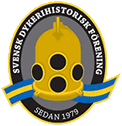In part 6 we take us from year 1918 – 1938.
(A good source in creating this chronology has been SPUMS Journal Volume 29 No.2 June 1999. Spums Archive
If you have rights to any of the images used to illustrate the material, please contact us via our contact form >, we will give you credit for the image, or remove it if you wish.)
1918 Watanabe Riichi
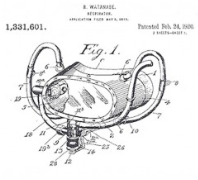
Japan’s Watanabe Riichi is patenting a surface – independent diving system called ”Ohgushi’s Peerless Respirator”. The diver controls his air supply with his mouth via two levers. The air supply takes place either from the surface or from two cylinders with 1,000 liters and a pressure of 150 bar.
The version that supplied air from the surface to the Ohgushi regulator was illustrated and described in the Russian Navy’s diving manual from 1945 and was apparently still in use at this time 70 .
1924 US Navy
The US Navy publishes the first standard for recompression procedure 71 .1926 Yves Le Prieur
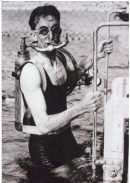
French naval officer Yves Le Prieur patented Frenez-Le-Prieur diving equipment. It consisted of a back mounted Michelin air cylinder connected to a Frenez nozzle. The diver wore Frenez goggles and a nose clip. The equipment was replaced in 1934 by the Le Prieur apparatus which used the same cylinder but mounted on the diver’s chest. A hand-controlled controller fed a continuous air stream to a full mask 72.
1928 Cunningham’s hyperbaric “Sphere”
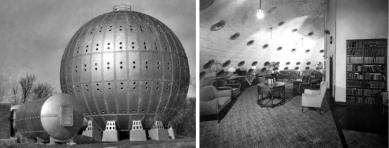
Despite the setbacks in 1921 when several patients died in connection with a sudden one uncontrolled pressure loss in the 25 m long chamber, Dr Cummingham built a gigantic ”air bath” sphere. The sphere was 22 meters in diameter and had 5 floors with 12 bedrooms on each floor. Here, patients would be treated with double atmospheric pressure for two-week periods.
At the heart of the plant was a powerful air-conditioning machine consisting of three compressors, two boilers, a 27-ton ammonia compressor that functioned as a dehumidifier and various air filters enabled precise control not only of the pressure, but also of the temperature, humidity and air exchange in the plant. The entire system was regulated and controlled by sensors that automatically adjusted the properties of the air.
Despite several inquiries from the American Medical Association, Cunningham answered only one and was expelled from the medical association. Then came the crisis of the 1930s and Cunningham was forced to sell the plant. Three owners later the facility was demolished and sold as scrap in 194273, 74.
1930 Tritonia
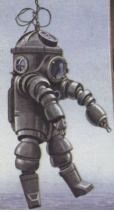
Joseph Salim Peress was an English diving engineer. In 1918 he was employed by the company WG Tarrant and was given free hands to create an atmospheric dive suit, ADS. He created the first truly useful ADS: Could Tritonia. In 1929, he considered himself to have solved the weight problem by using cast magnesium instead of steel. Peress claimed that the suit would work perfectly down to a depth of 370 meters, but it was never tested. Tritonia was first tested in a tank in 1930, after which Peress assistant Jim Jarret dived with it to 123 meters in Loch Ness. The suit worked perfectly. Further test dives were done and the costume was offered to the Royal Navy, but they declined as they felt that their diver never had to go deeper than 90 meters. As there was no interest in the suit, the project was closed down 75 . Peress was later also involved in the development of the ADS ”Jim”
1930 – 1934 William Beebe and Otis Barton
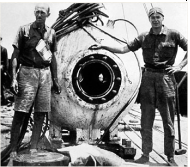
American naturalist William Beebe was allowed by the British government to set up a research station on the island of Nonsuch, Bermuda. Beebe planned to conduct an in-depth study of the animals that lived in an eight-square-mile ocean area, from a depth of 3.2 km to the surface. Although his original plan required the study to be conducted using helmet diving and bottom tests, Beebe soon realized that these methods were insufficient to gain a detailed understanding of deep-sea animals and began planning for a way to observe them in their original habitat.
By the end of the 1920s, the largest deep submarines had been down to was 117 meters, but they had no windows, making them useless for Beebe’s goal of observing deep sea animals. The deepest that any human being had at this time was 160 meters with an armor suit, but these suits also made movement and observations extremely difficult. What Beebe hoped to create was a deep-sea craft that could both go down to a much greater depth than any human had ever come down and that would also allow him to clearly observe and document the deep-sea wildlife.
Beebe’s original design was a cylindrical craft and articles describing his plans were published in The New York Times. These articles captured the interest of the engineer Otis Barton, he had already in 1928 begun to construct a spherical diving craft, he had his own ambition to become a deep-sea explorer. Barton was certain that a cylinder would not be strong enough to withstand the pressure of the depth to which Beebe was planning to go down, and sent Beebe several letters suggesting an alternative design for him. Many unqualified opportunists tried to be included in Beebe’s project, which was why Beebe tended to ignore most of Barton’s letters.
A mutual friend of Barton and Beebe eventually arranged a meeting between the two, which allowed Barton to present his design to Beebe personally. Beebe approved Barton’s design, and the two made an agreement: Barton would pay for the vehicle and all other equipment to accompany, while Beebe would pay for other expenses such as chartering a vessel to raise and lower the vessel.
Barton’s design was a sphere. The sphere had openings for three 76 mm thick windows made of molten quartz, the strongest transparent material available then, as well as a 180 kilo entrance hatch that would be bolted before descent. Oxygen was supplied from high-pressure cylinders transported inside the sphere, while vessels containing soda lime and calcium chloride were mounted inside the sphere’s walls to absorb exhaled CO2 and moisture. Air circulation would be achieved by the two crew members of the sphere waving with palm leaves. In a common cable there were wiring for electricity to a lamp and communication to the surface. In the final version, the Batysphere had a diameter of 1.45 meters and in surface position a weight of 2.25 tonnes to this came the 910 meter long steel wire for down and hoisting weighing 1, 35 tonnes. In order to avoid hitting the rocks during scuba diving to shallow depths, the Batysphere was later also provided with a rudder.
John Tee-van was the operational director of the two vessels used in the investigations and Gloria Hollister handled the communication between the surface and the sphere. On July 16, 1930, the two were accompanied on a trip in the sphere down to 120 meters, to celebrate Hollister’s birthday. She thus became the first woman in that depth.
Several depth records were set with the Batysphere and on August 15, 1934 it was taken down to a maximum depth of 923 meters. Then the entire lifting cable was released and the crane arm lowered to the maximum. However, the captain of the crane ship only allowed them to be at the maximum depth for five minutes. That record held until 1949 when Barton designed a new deep-sea craft called the Berthoscope that was taken down to 1,400 feet deep.
Thanks to the bathysphere, humans were able to see and film deep-sea animals for the first time in their natural environment. In 1930, Barton donated the bathysphere to the New York Zoological Society 76 . Today, the Bathysphere is at the New York Aquarium, Coney Island.
1932 Snorkel
The first snorkel intended for diving was patented in 1932. The name snorkel was taken from the name of the trachea used on German U-boats 77 . Later, snorkels with a top valve were developed to prevent water from entering the snorkel during diving and the bottom valve, to facilitate emptying.
1934 Dyktankhuset, Stockholm
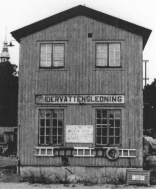
In 1934, the Swedish Navy built the house at the Galärvarvet in Stockholm. The house would be used for rescue training by submarine staff. In the house, there was, among other things, a six meter deep exercise tank and a pressure chamber, 10 bar, with a wet section. In the house, advanced hyperbaric medical research was also done until 1979 when the business was moved to Hårsfjärden. The house was saved from demolition the same year when the SwedishDiving Historical Association, SDHF was formed.
SDHF today runs a museum in the house together with the Maritime History Museum in Stockholm 78 . Read more about Dyktankhuset at About the Dytktankhuset.
1935 Scaphandres et de la vie sous l’eau
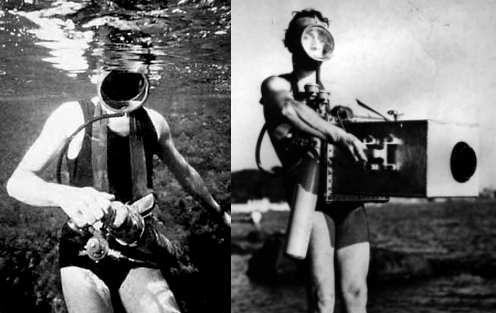 Yves Le Prieur och Jean Painleve´
Yves Le Prieur och Jean Painleve´The world’s first sports diving club was formed in Paris by Yves Le Prieur (see Yves Le prieur above) and Jean Painleve ’1935. However, due to a schism between the founders, the club was closed down as early as 1936 79 .
1938 Göterborgs Amatördykarklubb
The world’s oldest still active sports dive club, Gothenburg’s Amateur Dive Club was founded in 1938. The club purchased two diving equipment, Prieurapparater from France in 1939. The apparatus, Scaphandre Le Prieur consisted of a 2.7-litre pressure bottle 150 bar, a manually adjustable reducing valve, manometer and a large rubber mask with free flow. The bottle was carried on the chest so the diver could easily adjust the pressure and monitor the pressure gauge 80 .
References
70. Watanabe Riichi. Visited 20200428.
71. Thalmann ED. Principles of U.S Navy recompression treatments for decompression sickness. In Management of Diving Accidents.
Bennett PB and Moon RE, Eds. Bethseda, Maryland: Undersea and Hyperbaric Medical Society, 1990: 194-221
72. Yves Le Prieur Besökt 20200429.
73. Jain KK. The History of Hyperbaric Medicine. In Textbook of Hyperbaric Medicine. 2nd edition. Jain KK. Ed. Seattle: Hogrefe and Huber, 1996.
74. Cunningham Visited 20200429.
75.Peress. Visited 20200429.
76. William Beebe och Otis Barton. Visited 20200428.
77. Snorkel. Visited 20200501.
73. Dyktankhuset. Visited 20200429.
74. Scaphandres et de la vie sous l’eau. Visited 20200504.
75. Göteborgs Allmäna SportDykarKlubb Visited 20200429.
76. Lois de Corlieu Visited 20200504.
77. Snorkel.Visited 20200501.
78. Dyktankhuset. Besökt 20200429.
79. Scaphandres et de la vie sous l’eau. Visited 20200504.
80. Göteborgs Allmäna SportDykarKlubbBesökt 20200429.
